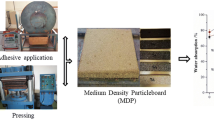Abstract
The steam-bending behavior of seven poplar hybrid clones from three growing sites was evaluated on kiln-dried specimens following two types of drying, an elevated-temperature and conventional schedule. The bending quality was assessed using quantitative and qualitative methods. In general, the poplar hybrid clones have poor steam-bending properties. The proportions of excellent pieces was low (13 %) compared to red oak (100 %), which was included as a reference for its excellent bending properties. Poplar specimens also showed a great memory effect and poor surface quality after bending. Among the parameters studied, only the clones showed a significant effect on bending properties. Hence, a clone selection could be done for bending improvement but it may be of minor significance.


Similar content being viewed by others
References
Richardson J (1998) Industrial potential of poplars in Canada. In: Proc of Annual Meeting of the Poplar Council of Canada, Quebec, Canada, 94 pp
Wangaard FF (1952) The steam bending of beech. J For Prod Res Soc 2:35–41
Peck EC (1957) Bending solid wood to form. Agric Handb 125 USDA Forest Service, Washington DC, 37 pp
Stevens WC, Turner N (1970) Wood bending handbook. Woodcraft & Supply Corp, Parkersburg, 109 pp
Sandberg D, Navi P (2007) Introduction to thermo-hydro-mechanical (THM) wood processing. School of Technology Design. Växjö University, Växjö, Sweden, 167 pp
Rice RW, Lucas J (2003) The effect of moisture content and bending rate on the work required to bend solid red oak. For Prod J 53:71–77
Eggert OT (1995) Stress relaxation in solid wood bending. In: Proc of the 12th International Wood Machining Seminar. Tokyo, Japan, pp 203–214
Jorgensen RN (1965) Furniture wood bending: an inquiry into the theory and practice of bending wood. Furnit Des Manuf 37:60–61
Kollmann FFP, Côté WA Jr (1975) Principles of wood science and technology. Solid Wood. Springer Verlag-New York, Heidelberg-Berlin
Lemoine TJ, Koch P (1971) Steam-bending properties of southern pine. For Prod J 21:34–42
Kubler H (1980) Wood as building and hobby material. Wiley, New York, 256 pp
Pliura A, Zhang SY, Mackay J, Bousquet J (2007) Genotypic variation in wood density and growth traits of poplar hybrids at four clonal trials. For Ecol Manag 238:92–106
Vallée G (1995) Projet du MRNQ sur l’amélioration génétique des peupliers dans la région du Saguenay—Lac Saint-Jean. In Proc Annual Meeting « Conseil du peuplier du Canada», Chicoutimi, Quebec, 181 pp
Hernández RE, Constantineau S, Fortin Y (2011) Wood machining properties of poplar hybrid clones from different sites following various treatments. Wood Fiber Sci 43:394–411
SAS Institute (2010) SAS/Stat user’s guide, release 9.3 ed. SAS Institute Inc, Cary
Ozarska B, Daian G (2010) Assessment of microwave bending capabilities for Australian wood species. For Prod J 60:64–68
Jalaludin Z, Samsi HW, Elham P (2007) Properties of bent rubberwood in different storing conditions. Born Sci (J Sci Tech) 20:56–64
Davis EM (1942) Machining and related characteristics of southern hardwoods. USDA Forest Service, Washington DC, 42 pp
Murakami R, Tanaka F, Norimoto M (2002) Relationship between bending quality and wood species. Wood Res 89:21–22
Bendtsen BA (1978) Properties of wood from improved and intensively managed trees. For Prod J 28:61–72
Acknowledgments
The authors acknowledge Pierre Gagné from Réseau Ligniculture Québec for his technical support. They are grateful to Luc Germain for their technical assistance on this project. They also thank M. Pierre Périnet from the Quebec Ministry of Natural Resources and Wildlife for providing the poplar hybrid clones material. They gratefully acknowledge Réseau Ligniculture Québec et Le Fonds Québécois de la Recherche sur la Nature et les Technologies for their financial contribution to this study.
Author information
Authors and Affiliations
Corresponding author
Rights and permissions
About this article
Cite this article
Kuljich, S., Cáceres, C.B. & Hernández, R.E. Steam-bending properties of seven poplar hybrid clones. Int J Mater Form 8, 67–72 (2015). https://doi.org/10.1007/s12289-013-1148-5
Received:
Accepted:
Published:
Issue Date:
DOI: https://doi.org/10.1007/s12289-013-1148-5




